Tag: rome
Italy, Travel
Surviving the Italian Pharmacy: A Traveller’s Guide to Feeling Better Abroad
Ever gotten sick while traveling? Here’s how to navigate Italian pharmacies like a pro.
We’ve all been there: you wake up in a foreign country with a scratchy throat, a pounding headache, or a stomach that regrets last night’s fourth helping of carbonara. Suddenly, your sunny Roman holiday turns into a hunt for medicine — and you quickly realize there’s no Walgreens, no Boots, and certainly no 24-hour Walmart nearby.
But don’t panic! Italian pharmacies are easy to find, and with this handy guide, you’ll know exactly what to say, where to go, and what to ask for when you’re feeling under the weather in Italy.
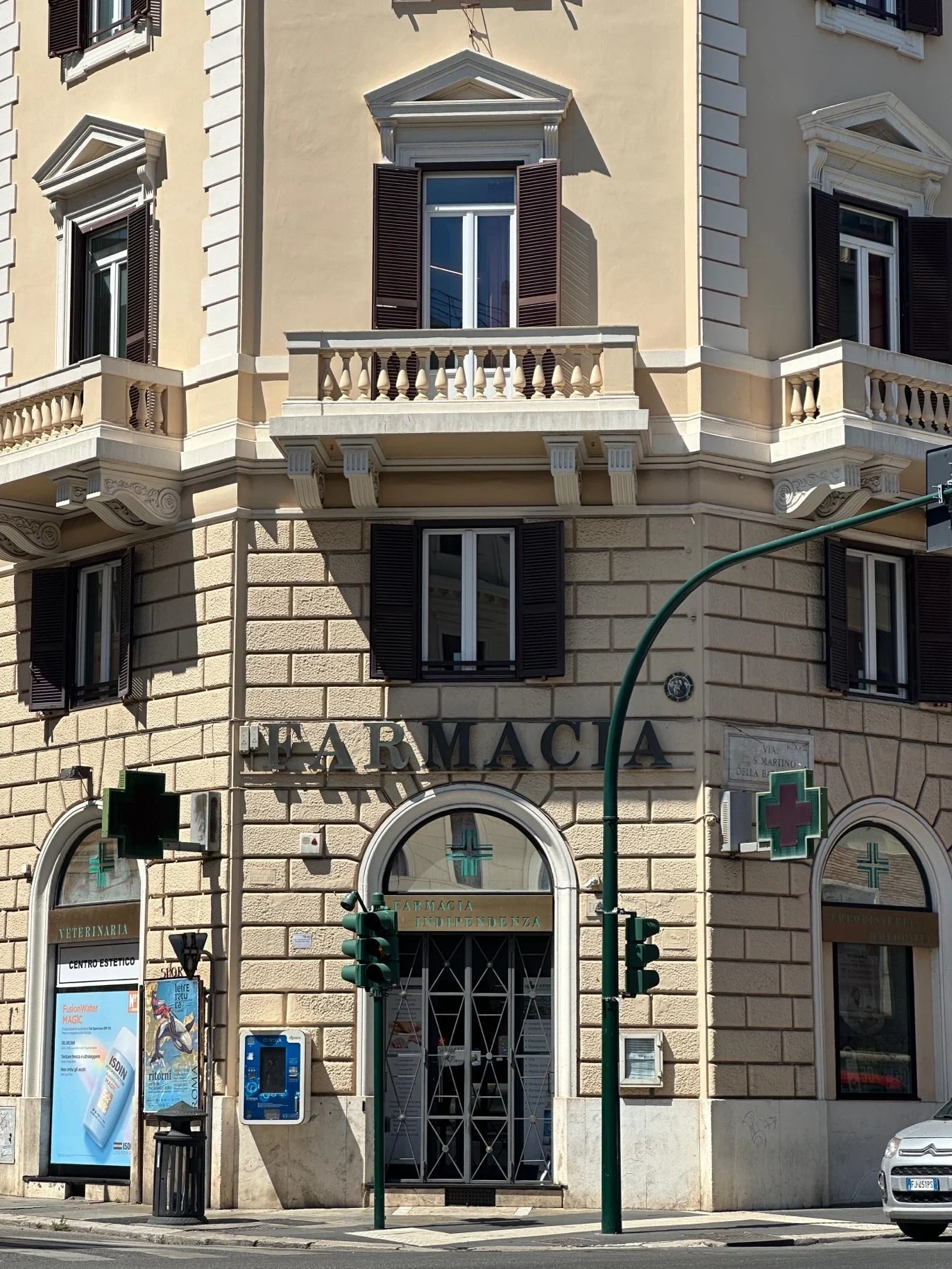
How to Spot a Pharmacy in Italy
Look for a green, glowing cross sign — this is the universal symbol for pharmacies in Italy. Most pharmacies (called a “farmacia” in Italian) are independently owned, and you’ll usually find at least a few in every neighbourhood.
In Rome, for example, there are over 10 pharmacies within a 10-minute walk of the YellowSquare, so you’ll never be far from help.
Pharmacies typically open from 8:30 AM to 1:00 PM and 3:30 PM to 7:30 PM, Monday through Saturday, with reduced hours on Sundays. If you’re unwell outside these hours, don’t worry — you can check which pharmacies are open later or on holidays via the Farmacie di Turno Roma website. It’s a useful tool for finding pharmacies currently open in your area, especially on Sundays and evenings.
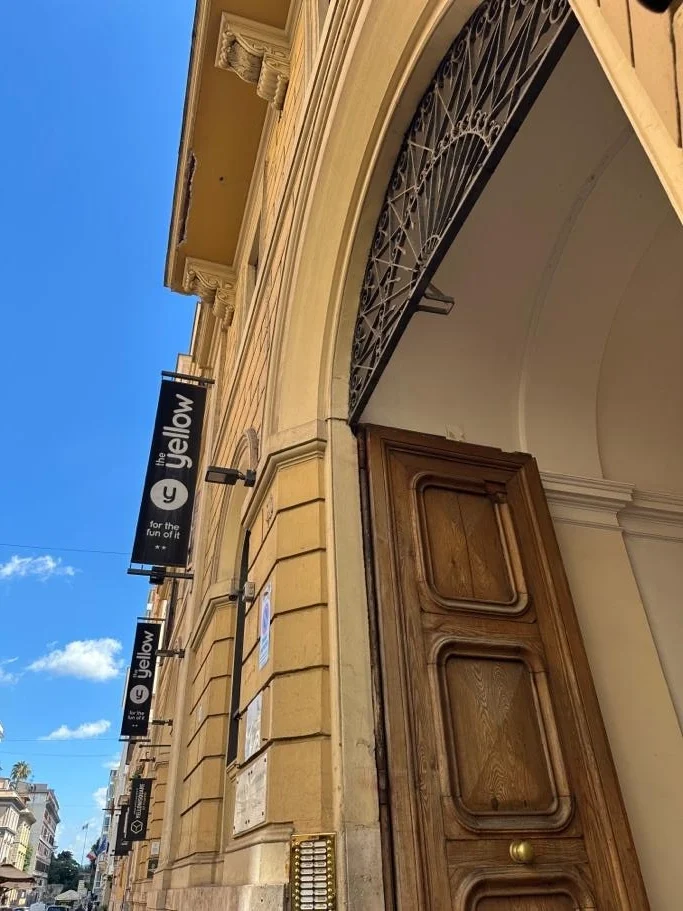
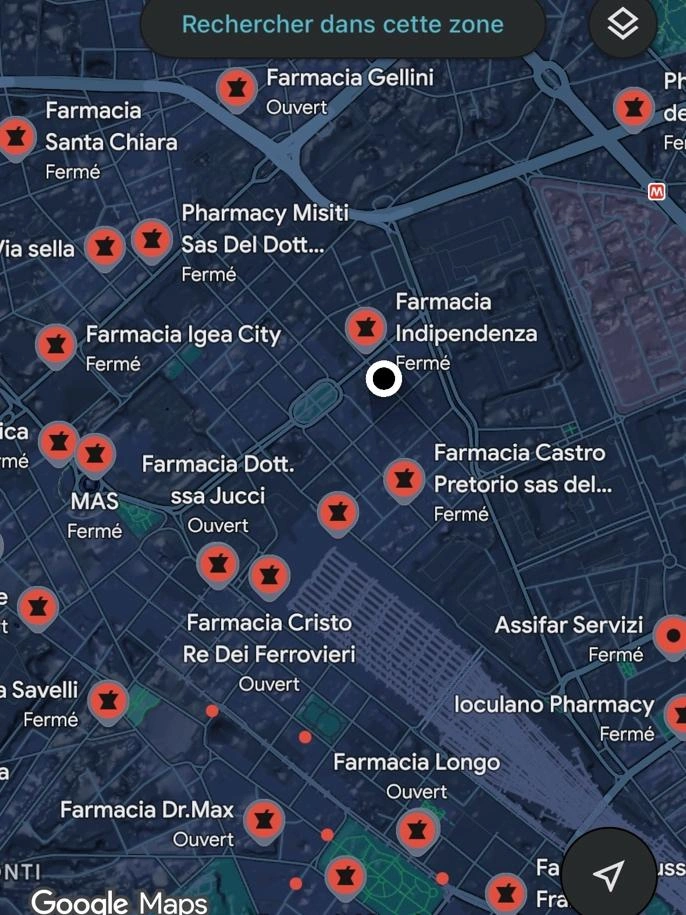
Cultural Curiosities:
Pharmacies Work Differently Here
In Italy, pharmacies aren’t mini-supermarkets like you might find in many English-speaking countries. While you’ll often find personal care items like shampoo, skincare, cosmetics, herbal remedies, and baby products, you won’t see shelves of snack foods, cold drinks, or everyday groceries next to your aspirin. Pharmacies here are primarily health and wellness hubs, and many over-the-counter medicines available elsewhere require a pharmacist’s approval.
Italian pharmacists act more like community health advisors — you describe your symptoms, and they’ll suggest the appropriate medication. This makes it incredibly helpful for travellers because even if you don’t know the name of the medicine you need, you can explain how you feel and they’ll find a solution.
Common Ailments & Their Italian Names
To make things easier, here’s a cheat sheet of common travel illnesses and their Italian translations:
- Flu = febbre
- Cold = raffreddore
- Allergies = allergie
- Cough = tosse
- Stuffy nose = naso chiuso
- Runny nose = naso che cola
- Sore throat = mal di gola
- Headache = mal di testa
- Migraine = emicrania
- Upset stomach = mal di stomaco
- Food poisoning = intossicazione alimentare
- Bug bites = punture di insetti
What to Say at the Pharmacy
If you want to be extra prepared, you can use this simple phrase:
“Buongiorno! Ho un [symptom] e cerco una medicina, per favore.”
(Hello! I have a [symptom] and I’m looking for medicine, please.)
Example: “Buongiorno! Ho un raffreddore e cerco una medicina, per favore.”
Most Popular Over-the-Counter Medicines
These are a few names you’re likely to hear:
- Tachipirina: Paracetamol-based, for fever and minor pain.
- Oki: Anti-inflammatory for sore throats, headaches, or joint pain.
- Moment: Ibuprofen for headaches, cramps, or fever.
- Enterogermina: Probiotic for stomach issues or after food poisoning.
- Imodium: Same brand as elsewhere, for diarrhoea.
- Vicks Tosse: Cough syrup.
- Zerinol: Cold and flu tablets.
Note: Antibiotics always require a doctor’s prescription in Italy.
Pharmacy Culture Tips: What Else You Should Know
Italian pharmacies have a few quirks that can surprise travellers:
- Most over-the-counter medicines are kept behind the counter. You’ll rarely see boxes of cold medicine on open shelves. Describe your symptoms and the pharmacist will retrieve what you need.
- Pharmacists are highly trained healthcare professionals in Italy. Think of them more like clinical advisors than cashiers. Don’t hesitate to ask for advice or recommendations.
Note: For prescription-only or controlled medications, you may occasionally be asked for ID or a prescription from a local doctor; but for standard pharmacy purchases, it isn’t required.
What NOT To Do
- Don’t take medications without knowing exactly what they are and what they’re for. Even if a fellow traveller swears by something, check with a pharmacist first — some drugs available elsewhere might not be recommended or necessary for your symptoms.
- Always double-check ingredients on unfamiliar medicine. Products might have the same active ingredients as what you’re used to under a different name, or be completely different but used for the same thing. Ask the pharmacist to explain it if you’re unsure.
- Consider seeing a doctor if your symptoms persist more than a few days or get worse. You can book English-speaking doctors online via services like Doctors in Italy.
Final Thoughts
Getting sick abroad can be stressful, but it doesn’t have to ruin your trip. With this guide, you’ll be ready to face the Italian pharmacy system confidently, whether you need a quick fix for a hangover headache or something more serious.
Stay safe, travel smart, and remember to pack a basic travel medicine kit before you go!
Links
- Farmacie di Turno Roma list: https://www.farmaciediturno.org/comune.asp?cod=58091
- Google Maps results for pharmacies near YS Rome: https://maps.app.goo.gl/JYaHNTBKgx2EZLUB7
- YS Rome’s closest pharmacy: https://maps.app.goo.gl/8hDhFKSAssMnBjU98
Service for finding English-speaking doctors: https://www.doctorsinitaly.com/
Read more posts
Rome
Have you seen the sky above Rome?
A stop to add to your Roman itinerary—less mentioned in tourist guides but definitely more local—is Monte Ciocci.
This scenic overlook sits about 50 meters above the city, in a park frequented by families and university students who gather here for a picnic, some guitar playing, or simply a beer on the steps.
The park is located in the Valle Aurelia area, it’s close to Castel Sant’Angelo, the Vatican Museums, and St. Peter’s Basilica, so a good idea would be to spend the first part of your day visiting these well-known sights, then head up to the hill at sunset to fully enjoy the golden hour while admiring Rome from above.
The write on the wall:
“Hai visto il cielo sopra Roma e hai detto quant’è bello, viettelo a vedè dall’alto.”
This is the phrase that made this spot iconic. It’s a line from the song “Il cielo su Roma” by the Roman hip-hop group Colle Der Fomento. One day it appeared as graffiti, almost by chance, and soon became the symbol of this scenic overlook. So much so that when the city cleaned the wall and removed it, locals reacted with disappointment and when someone spray-painted it back, everyone celebrated!
Google Translate might help you understand the first part of the sentence, but the second half is in Roman dialect. The full meaning is:
“You’ve seen the sky above Rome and said how beautiful it is, now come to see it from from up high .”

To be fair, this has become one of the most famous “muretti” (low walls) in Rome.
Due to its visibility, it often becomes a canvas for someone who decides to paint over the original message with their own. So don’t be surprised if you get there and the iconic phrase is missing—but rest assured, there’s always a local hero who steps in to restore the status quo and bring back the Romans’ favorite line.
The Sunset:
Monte Ciocci’s belvedere offers one of the most beautiful sunsets in Rome—though it’s a bit unconventional. It’s actually the only sunset in the city that you watch with your back to the sun!
Because of the way the viewpoint is oriented, especially in spring and summer, the sun sets proudly over a rather plain side of the city. While that in itself is still an awe-inspiring view, Romans usually sit on the steps and turn their gaze the other way—toward the city.
Why? Because the sky fills with warm shades of pink and orange as Rome unfolds beneath you like a painting. In that moment, you understand why they call it the Eternal City—it truly feels like time stands still, just like in Roma Capoccia, the beloved song by iconic Roman singer-songwriter Antonello Venditti, a true anthem to the city.
Il pizzarium:
Here a tip: pair the sunset with a top-level, internationally renowned yet truly local gastronomic experience: Bonci’s pizza!
The place is called Pizzarium and it’s located near the Cipro stop on Metro line A. The exact address is Via della Meloria, 43.
Gabriele Bonci is considered the king of Roman-style street food pizza, the “pizza al taglio”. In 2024, at the Pizza Doc Awards, he won the Absolute Excellence prize – “Awarded forrevolutionizing the concept of pizza al taglio, turning it into an extraordinary gastronomic experience.”

On the counter, you’ll find a wide variety of pizzas. It’s hard to make a list because they change constantly, both because only seasonal ingredients are used and because the chef is always researching new combinations and flavors.
Even though some of the “gourmet” pizzas are truly mouthwatering, my honest advice is to absolutely try the simpler ones: bianca, rossa, margherita, and potato pizza, because the secret to the best pizza al taglio in the world is not in the toppings, but in the dough!
How to Get There:
To reach the viewpoint, you have to climb a staircase that’s a bit hidden and definitely not well maintained. The entrance is actually behind a gas station; it’s quite steep and for most of the year, overgrown weeds take over.
Personally, though, I think this makes everything feel a bit more magical and adventurous, giving this spot that hidden gem status that makes it so special.
So don’t be discouraged, hold on tight to your pizza and climb those steps. Rome in all its beauty is waiting for you!
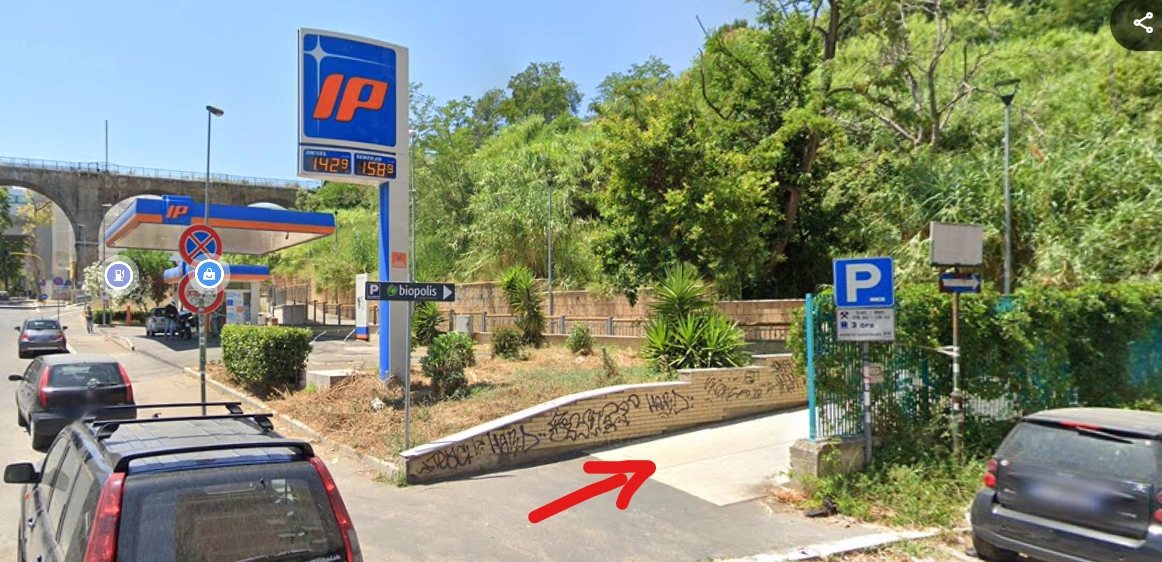
Excact position of the staircase: https://maps.app.goo.gl/1frDr5vAxtjaa8g58
Soundtrack for the Sunset
- Roma Capoccia – Antonello Venditti
YouTube |
Spotify - Il Cielo su Roma – Colle der Fomento
YouTube |
Spotify
Read more posts
Rome, Travel
Tour Yourself on, Rome
(A journey among pilgrims, poets, and dreamers, following the golden thread of the Tridente)
Rome: the pleasure of getting lost… and the gift of finding yourself again
How wonderful is it to get lost among the little streets of Rome?
It’s truly a walk filled with the pleasure of discovery: the magnetism of the unexpected wonders we stumble upon is undeniable.
However, after years of living here, I must admit that it’s even more beautiful not to get lost, but rather to know how to find yourself again, using the secret connection between squares, churches, and monuments as your guide.
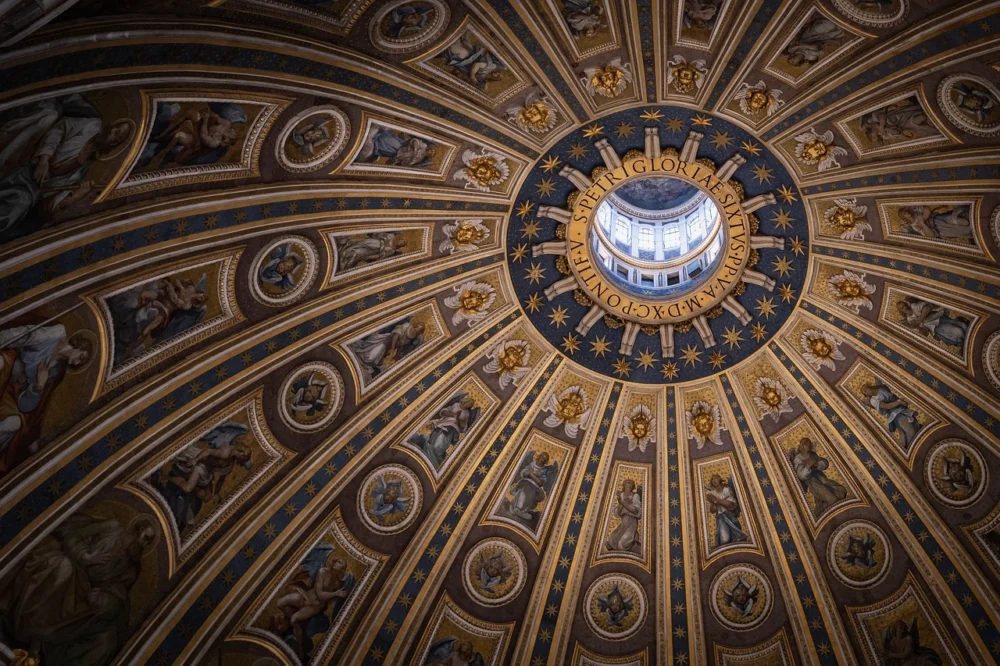
A small dive into history: the Council of Trent and the changing face of Rome
As we move from church to church like modern pilgrims, it’s worth remembering that this way of experiencing the city has deep roots in history.
After the Council of Trent (1545–1563), during the height of the Counter-Reformation, the Catholic Church decided to renew not only its doctrine but also the very face of the cities.
In Rome, this led to a vast program of construction and renovation of churches, conceived as visible instruments of faith and power.
And not only that: to lead the faithful toward these new temples of spirituality, streets were straightened and newly created, often aligning roadways directly to places of worship.
Thanks to this drive, monumental works like the Tridente were born — the perfect crossroads of faith, urban planning, and beauty — along with many of the squares we explore today.
Thus, as we walk, we unconsciously retrace the blueprint of an era that sought to guide souls… with straight roads pointing towards the heavens.
Just like the pilgrims of the past: going from church to church, walking with wonder in their eyes, much like the first “tourists” in history.
And so, let’s begin at Rome’s “gateway of gateways”: Porta Flaminia, better known today as Porta del Popolo.
As soon as you pass through it, Piazza del Popolo opens up before you with its iconic Tridente: three streets branching out like the prongs of a trident, part of a great urban project carried out in the 16th century.
Before setting off, however, take some time to explore the square: it’s full of surprises.
From walls that mysteriously carry your voice like an echo, to Caravaggio’s masterpieces housed in the Church of Santa Maria del Popolo, and even to the small but fascinating Leonardo da Vinci Experience Museum.
And of course, don’t forget that this square is still today a place for public gatherings: events, protests, and celebrations can offer you a living, authentic experience of the city.
Now, let’s talk about the Tridente.
To guide us, we’ll use a culinary metaphor: each street will represent a meal of the day — breakfast, lunch, and aperitivo/dinner.
Are you ready to experience Rome like true pilgrims… and a little bit like romantic poets and painters too?
Babuino for Breakfast
We start our journey by taking Via del Babuino, perfect for an energetic walk toward the Monti area.
Imagine yourself in the 1800s: a romantic poet, a flâneur, inspired by the old and new air of Rome.
Then return to the present and glance at the prices in the shop windows: you’re in the heart of Rome’s luxury district!
Along the way, we discover a gem: Canova Tadolini, an old sculpture studio founded in 1818, now transformed into a restaurant-museum.
Here, the tables seem like secondary guests to the majesty of the sculptures surrounding you. A magical place where art fills every corner.
Just a few more steps and here we are at Piazza di Spagna, with the famous Fountain of the Barcaccia sculpted by the Berninis and, of course, the spectacular Spanish Steps leading up to Trinità dei Monti.
A climb that is a true feast for the eyes, culminating in the panoramic view from the balconies of Trinità dei Monti, where Rome unfolds below you like an endless painting.
We continue to the right along Via Sistina, leading to Piazza Barberini, dominated by Bernini’s Triton Fountain.
Just a little further on, we find a hidden masterpiece: The Four Fountains and Borromini’s tiny but stunning church of San Carlo alle Quattro Fontane.
If we continue straight, we reach the majestic Basilica of Santa Maria Maggiore, one of the four papal basilicas.
Right across from it, you can enjoy a well-deserved breakfast at one of the local cafés: a cappuccino and a croissant will recharge your energy for more adventures.

Through Monti Toward the Colosseum
From Santa Maria Maggiore, look at the map: from here, four roads radiate out toward other monuments and little squares.
We take Via Urbana to enter the Rione Monti, one of the most fascinating districts of Rome, with a rich and varied history: from ancient Roman neighborhood to medieval Jewish ghetto, and today, the beating heart of art and urban creativity.
Stroll at your leisure to Piazza della Madonna dei Monti, the “living room” of the neighborhood, and get ready: just a few steps away, the Colosseum will suddenly appear, like an ancient giant welcoming you.
The journey continues through the Imperial Forums, an emotional plunge into Ancient Rome, until you reach the imposing Altar of the Fatherland (Vittoriano).
From there, look back: you’ll see Piazza del Popolo in the distance.
Just like an invisible thread, the streets of the Tridente still connect us.
A Quick Lunch near the Corso?
If you’re feeling hungry, it’s the perfect time for lunch!
You can choose to be treated like royalty in an elegant restaurant or to live a more “authentic” experience in a typical Roman osteria, where the chatter and warmth of the locals will embrace you.
A perfect example? The historic Birreria Peroni, where the genuine atmosphere of a Roman lunch among friends is still alive today.
Don’t be surprised if, after your meal, they kindly ask you to give up the table: it’s part of the Roman ritual of “eat and move on”!
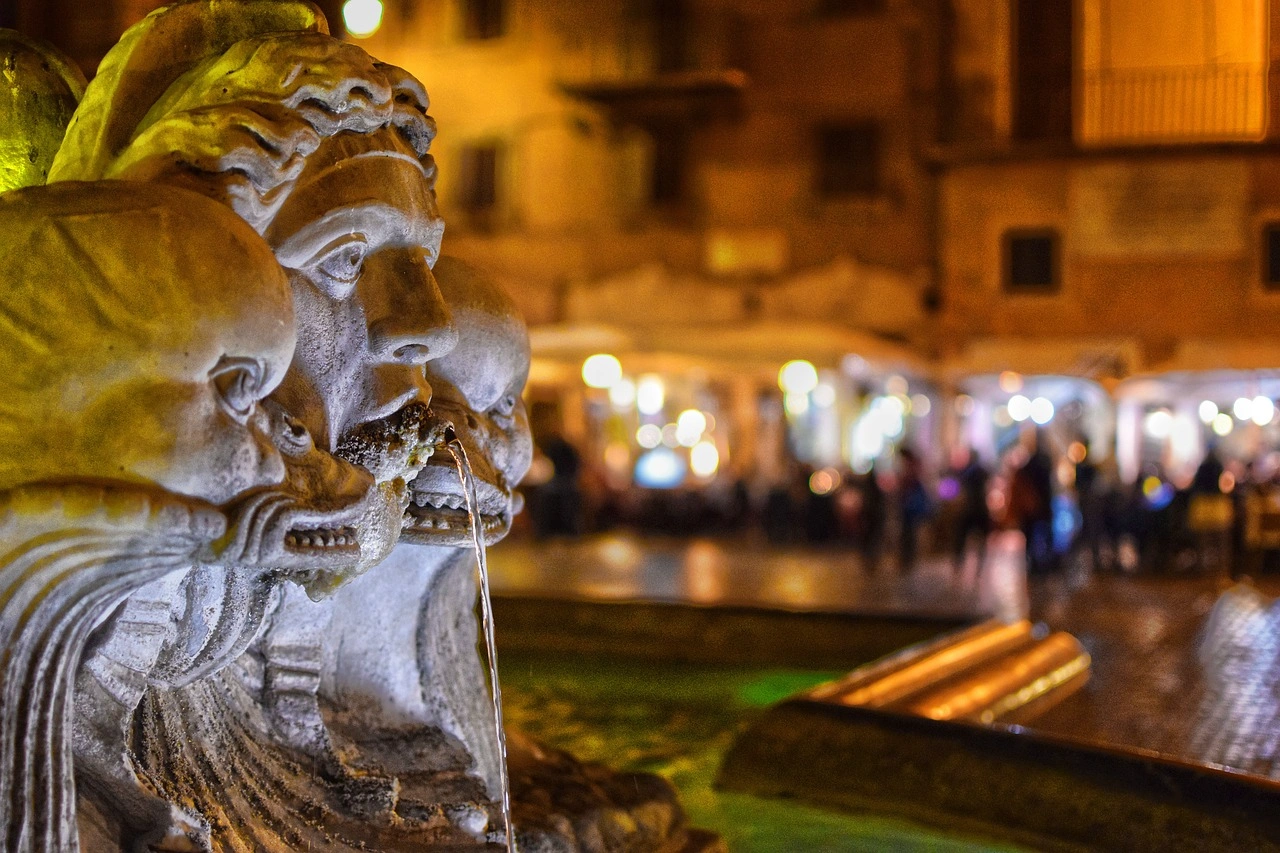
Aperitivo in Trastevere: Bohemian for an Evening
After lunch, if you want to immerse yourself in one of the most celebrated Italian traditions, an aperitivo is a must!
And the ideal neighborhood for it is definitely Trastevere, across the Tiber River.
The path to reach it is like a dream: passing by the majestic Pantheon, the spectacular Piazza Navona, the solemn Palazzo Madama, until you arrive at the Basilica of Sant’Agostino in Campo Marzio, where you can admire Caravaggio’s famous Madonna of the Pilgrims.
This church, by the way, is visually aligned with Piazza del Popolo, showing once again how the Tridente subtly guides us without letting us get lost.
Then, cross the Tiber Island, a legendary place considered one of the very first settlements of Ancient Rome.
From there, a final short walk takes you to Trastevere, where I recommend booking a table at a typical restaurant (perhaps to enjoy a dreamy cacio e pepe or a rich amatriciana).
While waiting for dinner, with a spritz in hand — yes, in Italy it’s allowed to drink outdoors until 10 PM — enjoy a leisurely stroll among the lantern-lit alleyways.
At Piazza Trilussa, you will always find street artists, musicians, and mimes: it’s the bohemian heart of Rome, where simplicity lives side by side with ancient beauty.
Close your eyes for a moment: listen to the sounds, observe the colors, breathe in the atmosphere.
You’ll understand that, despite the centuries, nothing has changed: Rome is still that eternal crossroads of peoples, languages, dreams, and poetry.
Online fonts:
.https://it.wikipedia.org/wiki/Urbanistica_a_Roma_tra_il_1870_e_il_2000
.https://www.pexels.com/it-it/cerca/roma%20piazza%20del%20popolo/
Read more posts
Rome
Gaeta: a perfect escape between sea, nature, and legend
Less than two hours from Rome, Gaeta is the ideal destination for a day trip that combines nature, culture, and food.
Located between Lazio and Campania, this coastal town offers breathtaking views, golden beaches, and a culinary tradition full of authentic flavors.
How to get to Gaeta from Rome
By train + bus
The easiest way to reach Gaeta is by taking a regional train from Roma Termini to Formia-Gaeta, which takes about 1 hour and 15 minutes. From the station, hop on a local bus (line C or U) and in around 15–20 minutes you’ll arrive in Gaeta’s city center. If you prefer, you can also take a taxi or use a car-sharing service.
By car
If you’re up for a little road trip, drive south on the SS7 Appia and you’ll reach Gaeta in just under two hours. Along the way, you might want to stop for a quick coffee or take some photos with a sea view.
Now that you know how to get there, here’s how to make the most of a perfect day in Gaeta.
Explore the Montagna Spaccata and Grotta del Turco
Start your day with a short hike up Monte Orlando. At the top, you’ll find the Sanctuary of the Montagna Spaccata—a place where nature, legend, and spirituality come together.
According to tradition, the three massive cracks in the rock were formed at the moment of Christ’s death—hence the name “Split Mountain.”
Inside, there’s a small stone chapel often visited by pilgrims and travelers seeking peace and silence.
Just below the sanctuary, a staircase of 35 steps leads you to the Grotta del Turco, a narrow sea canyon where waves crash between the cliffs in a play of light and shadow. Legend has it that a skeptical Turkish sailor touched the rock and left a handprint—still visible today—when the stone softened miraculously.
Take your time to enjoy the calm, the atmosphere, and the natural light—especially if you love photography.

Seaside lunch with the famous Tiella
You haven’t really been to Gaeta until you’ve tasted a tiella, a traditional dish that blends maritime and peasant flavors.
Tiella is a savory pie, baked and served warm or cold. The most famous version is stuffed with octopus, Gaeta black olives, tomato, garlic, and parsley, but you’ll also find options with escarole, onion, or anchovies.
Try it at “Antico Forno Giordano” or “La Tielleria”, two spots beloved by locals. My tip? Buy one and enjoy it by the sea or on a bench along the promenade for the full experience.

Discover the Cappella d’Oro
After lunch, head to the old town and look for the Santuario della Santissima Annunziata. Inside, hidden away, is a small gem: the Cappella d’Oro.
Built in the 14th century and decorated in rich Baroque style, this chapel is known for its golden stuccos, intricate paintings, and a ceiling that seems to glow.
On the altar is a beautiful image of the Immaculate Conception, created by Scipione Pulzone, to whom the chapel is dedicated.
It’s a quiet, lesser-known place—perfect for a short break before returning to the sea.
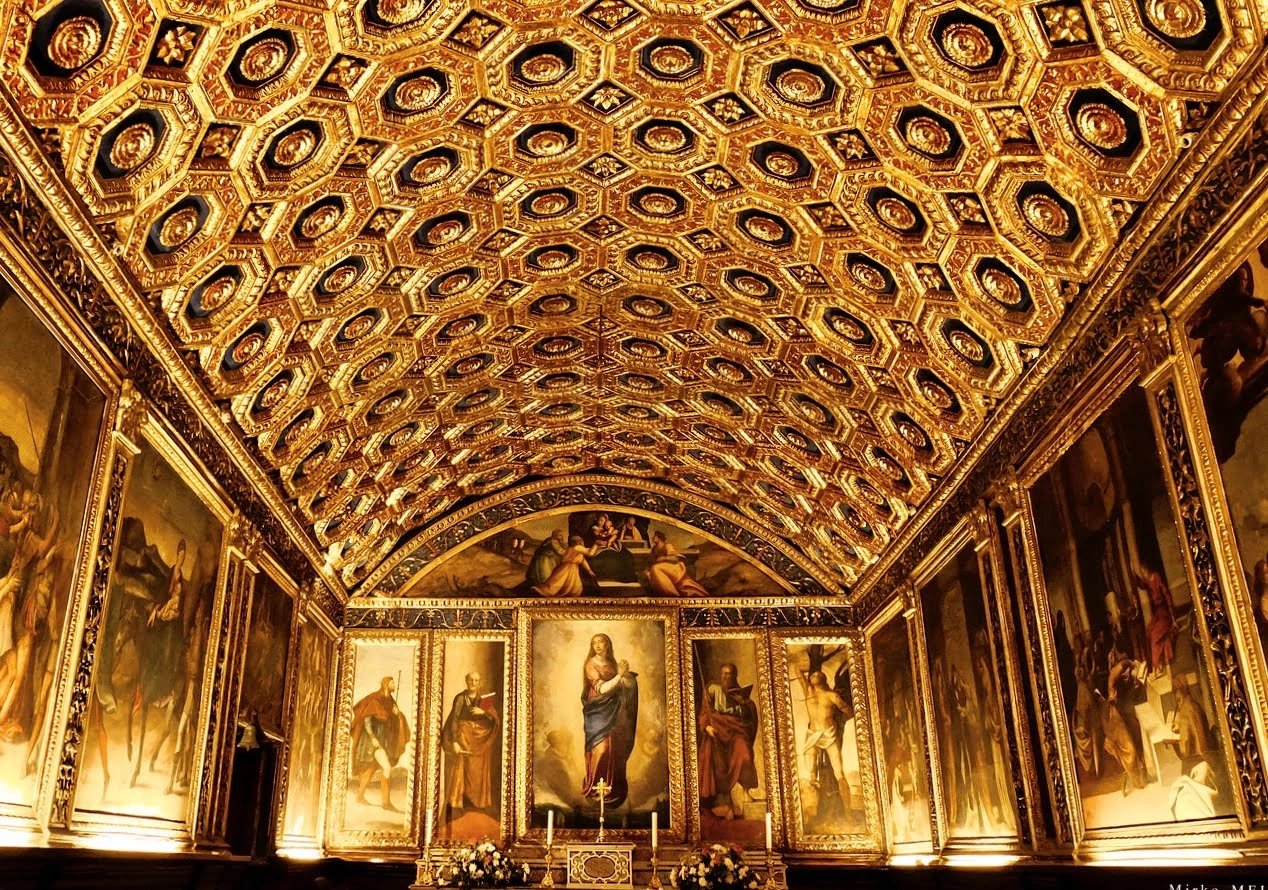
Relax at Serapo Beach
To end the day: beach time, sun, and a bit of relaxation.
Head to Serapo Beach, the most popular beach in Gaeta, loved by locals, families, and visitors. Just a short walk from the center, it’s surrounded by nature and perfect for swimming, relaxing, or snorkeling.
Nearby, the small “Nave di Serapo” islet—linked to Greek mythology—is known for its vibrant colors and biodiversity.
If you’re lucky, you might even catch the sunset painting the cliffs of Monte Orlando in soft pink hues.

I visited Gaeta last summer, and with its beautiful landscapes and peaceful vibe, it really won me over. Between the crystal-clear sea, the air of legend, and the local traditions, it was a day I won’t forget.
But Gaeta is just one of the many treasures along the Lazio coast. If you have the time, I definitely recommend exploring nearby towns like Sperlonga, or even better—spending a whole weekend discovering the area. It’s the perfect opportunity to unwind and enjoy life away from the city.
Hope this helps you plan your next day trip—especially now that summer’s just around the corner.
Enjoy the sun! 🌞
Read more posts
Rome
Where to See Caravaggio for Free in Rome
I’ve been living in Rome for a while now and this city never stops intriguing me!
Sometimes me and my boyfriend revisit familiar places and to remember old historical facts. We never stop learning new and interesting things in Rome.
This time it was about Caravaggio. I remembered doing a tour when I was learning Italian in 2018. One day in 2024, my boyfriend said:
“What do you know about Caravaggio? Do you know there are free masterpieces to see around?”
I said: “YEP! I don’t remember how to get to all the places though, but let’s try!”
Since I couldn’t remember the full itinerary, after we found our way, I decided to write some quick walking tips for myself and friends. That later became this article for YellowSquare, since I always use the spot as my starting point. This way I won’t forget it next time =)
Discover Free Caravaggio in Rome on a free walking
Who Was Caravaggio?
Michelangelo Merisi da Caravaggio, the revolutionary Baroque painter, left an indelible mark on Rome with his dramatic use of light and shadow. The Eternal City houses some of his greatest works—and the best part? Many can be seen for free!
Follow this self-guided walking tour to discover Caravaggio’s masterpieces in churches across the historic center of Rome.
Starting Point to the free walking
I used the Yellowsquare Rome as the starting point to get the directions as it also central, near Termini Station, where I always park my car and grab a coffee. So feel free to get one yourself at Yellow Bar. From there we are going to head to the first church in Piazza Navona into the heart of the historical center. I like to walk, but you can check buses and the nearest metro station.
1. San Luigi dei Francesi
Address: Piazza di San Luigi de’ Francesi, 00186 Rome – Contarelli Chapel
Opening hours: Every day from 09:30AM – 12:15 PM, 02:30PM – 6:30PM
A short walk from Piazza Navona brings you to the French national church in Rome.
Inside the Contarelli Chapel, you’ll find one of Caravaggio’s most famous triptychs:
- The Calling of Saint Matthew (1599–1600)
- The Inspiration of Saint Matthew (1602)
- The Martyrdom of Saint Matthew (1599–1600)
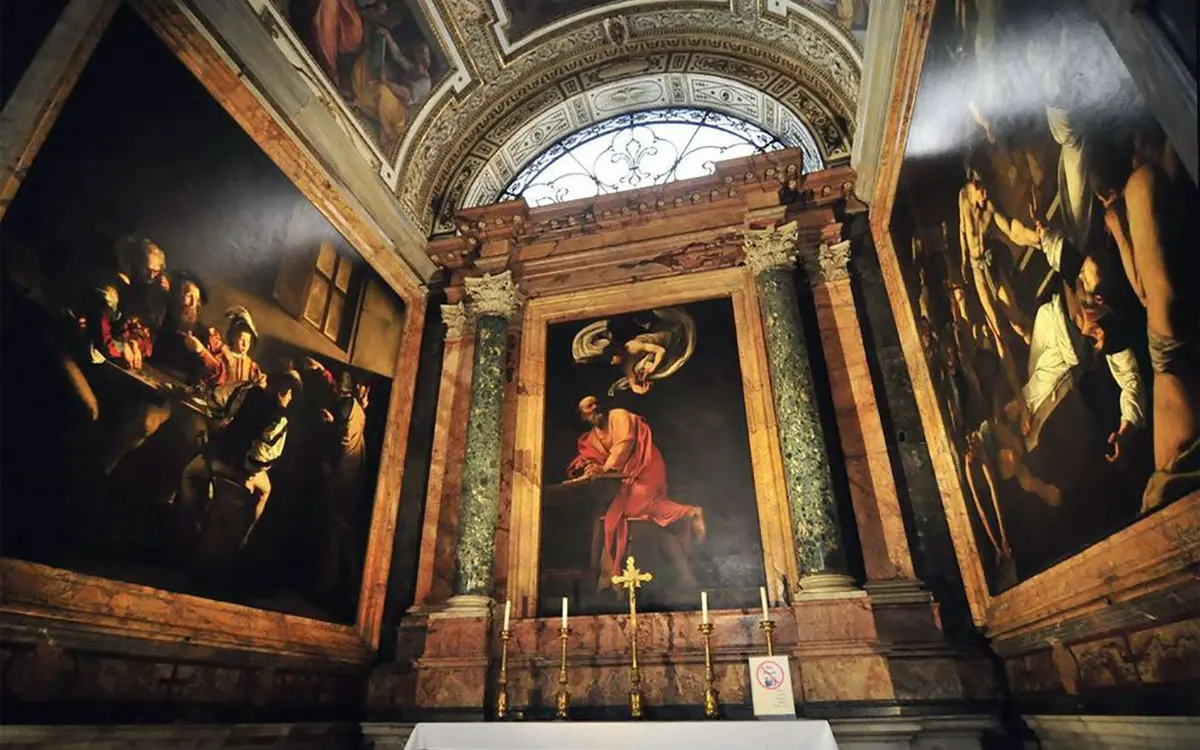
These paintings show key moments in Saint Matthew’s life with intense realism. The church is free to enter, but a small donation is encouraged to light up the paintings.
2. Sant’Agostino
Address: Piazza di Sant’Agostino, 00186 Rome
- Just a few minutes away is the church of Sant’Agostino, where you can admire Madonna di Loreto (1604–1606).
Opening hours: From Monday to Saturday 09:00AM – 11:30 AM, 4:00PM – 5:00PM / On Sundays: 4:00PM – 5:00PM
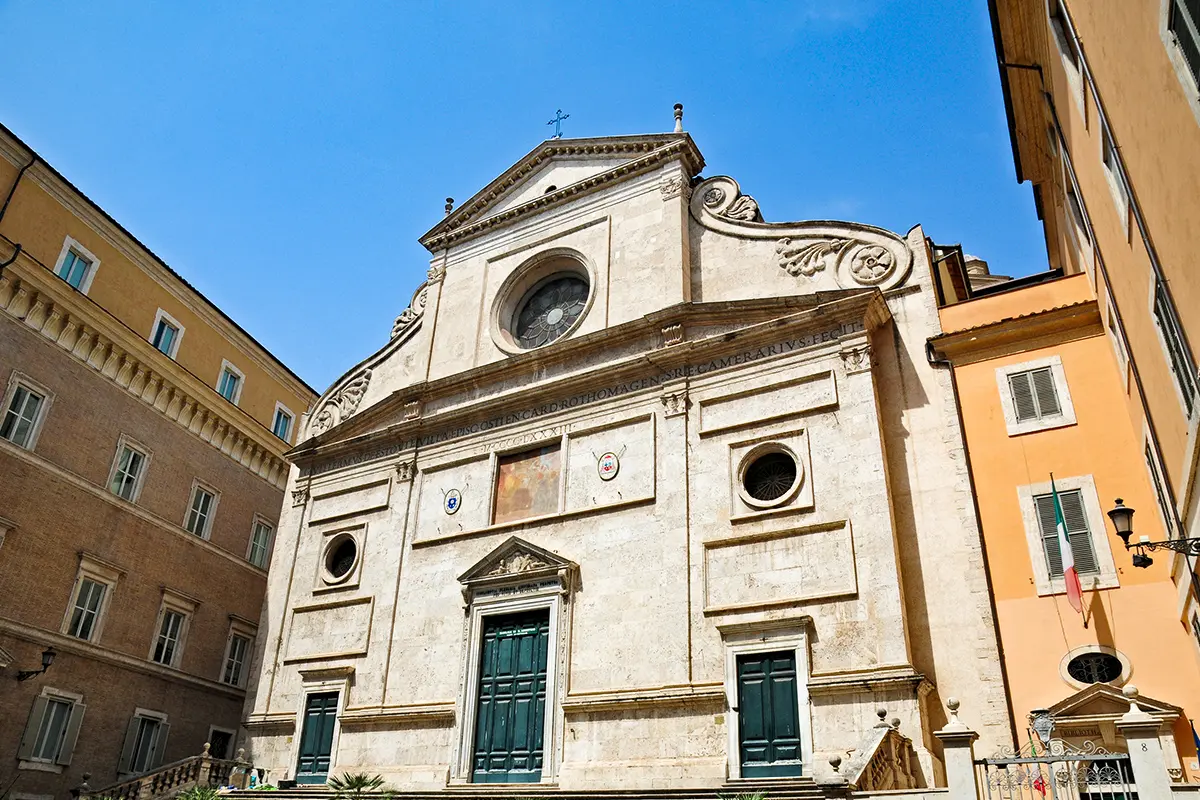
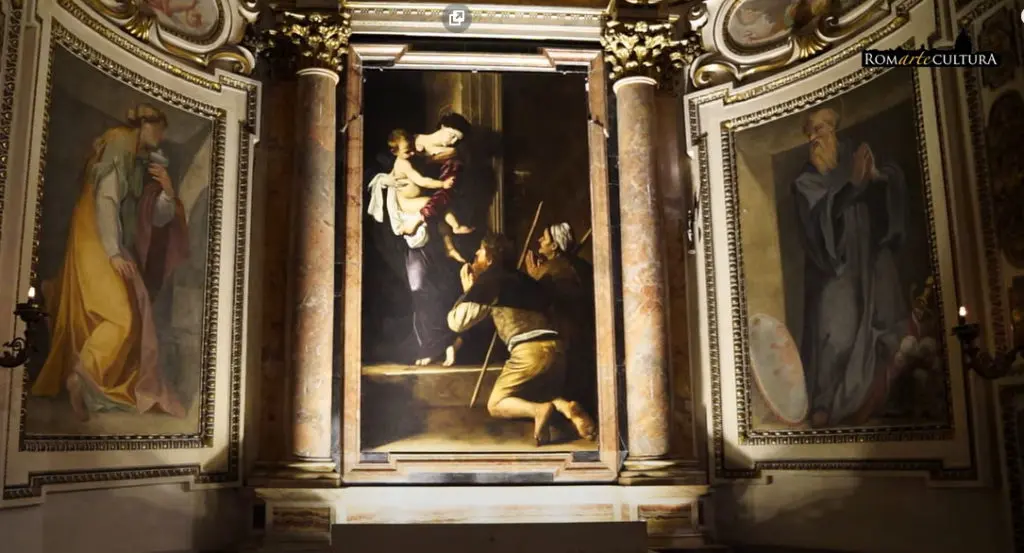
This unconventional depiction of the Virgin Mary—with bare feet and lifelike textures—caused scandal in its time. The painting is near the entrance, on the left side of the church.
3. Curiosities About Caravaggio in Rome
His Home, Tavern, and Crime Scene
Where he lived while in Rome
Address: Vicolo del Divino Amore, near Piazza Navona
Caravaggio lived in various spots in Rome. One known residence was near Piazza Navona. He often got into brawls and disputes, which shaped his chaotic life and art.
Here you need to pay a lot of attention and you will also see signs pointing in the direction of his house. Then when you get in this small little lane, you will see another sign saying where it was his apartment and an automatic light will pop up to illuminate the street if it’s night.
Notice the window in the image below. It’s believed Caravaggio used light from such sources to meticulously study the interplay of shadows and illumination. The overhead light coming from the window creates a specific pattern, highlighting the subjects, and providing a key to his dramatic style.
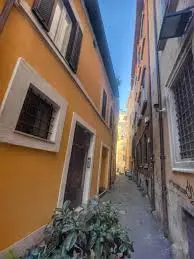
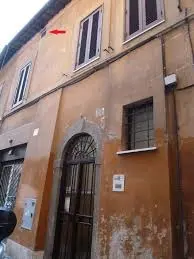
Where he used to drank
Address: Bar dell’Orso, near Campo de’ Fiori
Well, we know Caravaggio’s fame about drinking and he used to frequent taverns around Campo de’ Fiori! Though this “tavern” was more than only that, it was a place where artists, rebels, and rogues gathered to drink and debate, discuss about art and society.
Where he stabbed someone
Address: Via della Pallacorda, 00186 Rome
In 1606, Caravaggio fatally stabbed Ranuccio Tomassoni during a violent fight. He fled Rome soon after, beginning his restless travels and went to Florence.
4. Basilica di Santa Maria del Popolo
Address: Piazza del Popolo, 12, 00187 Rome.
Opening hours: Every day from 07:30AM – 7:00PM
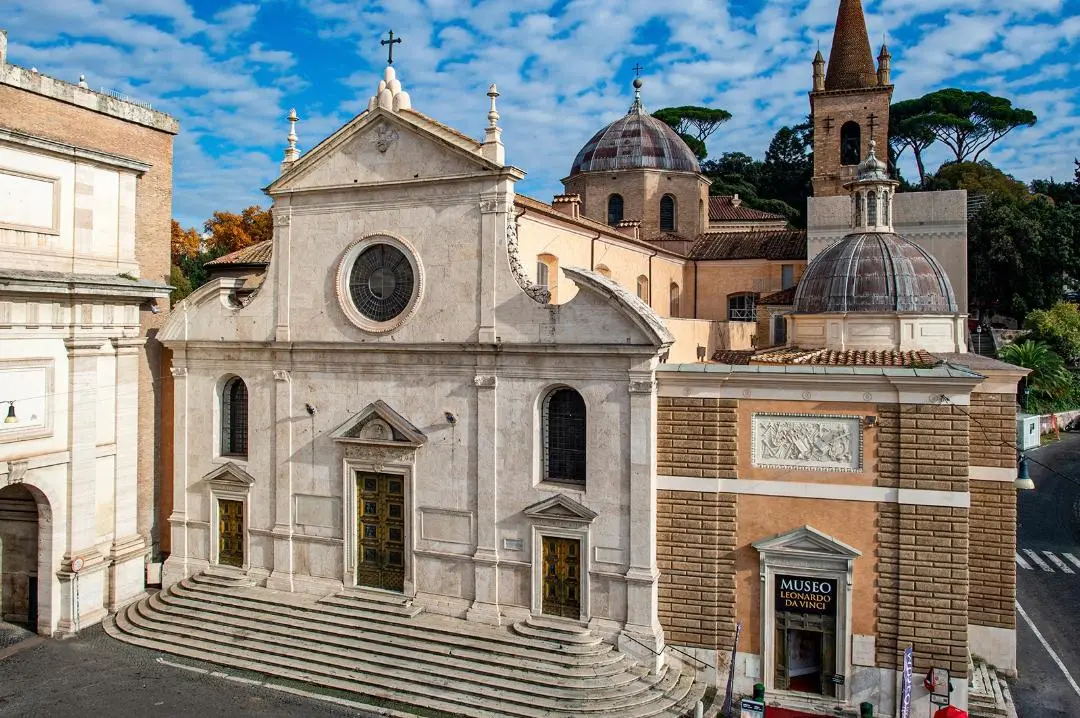
Inside the Cerasi Chapel, you’ll find two of Caravaggio’s most intense works:
- The Conversion of Saint Paul (1601)
- The Crucifixion of Saint Peter (1601)
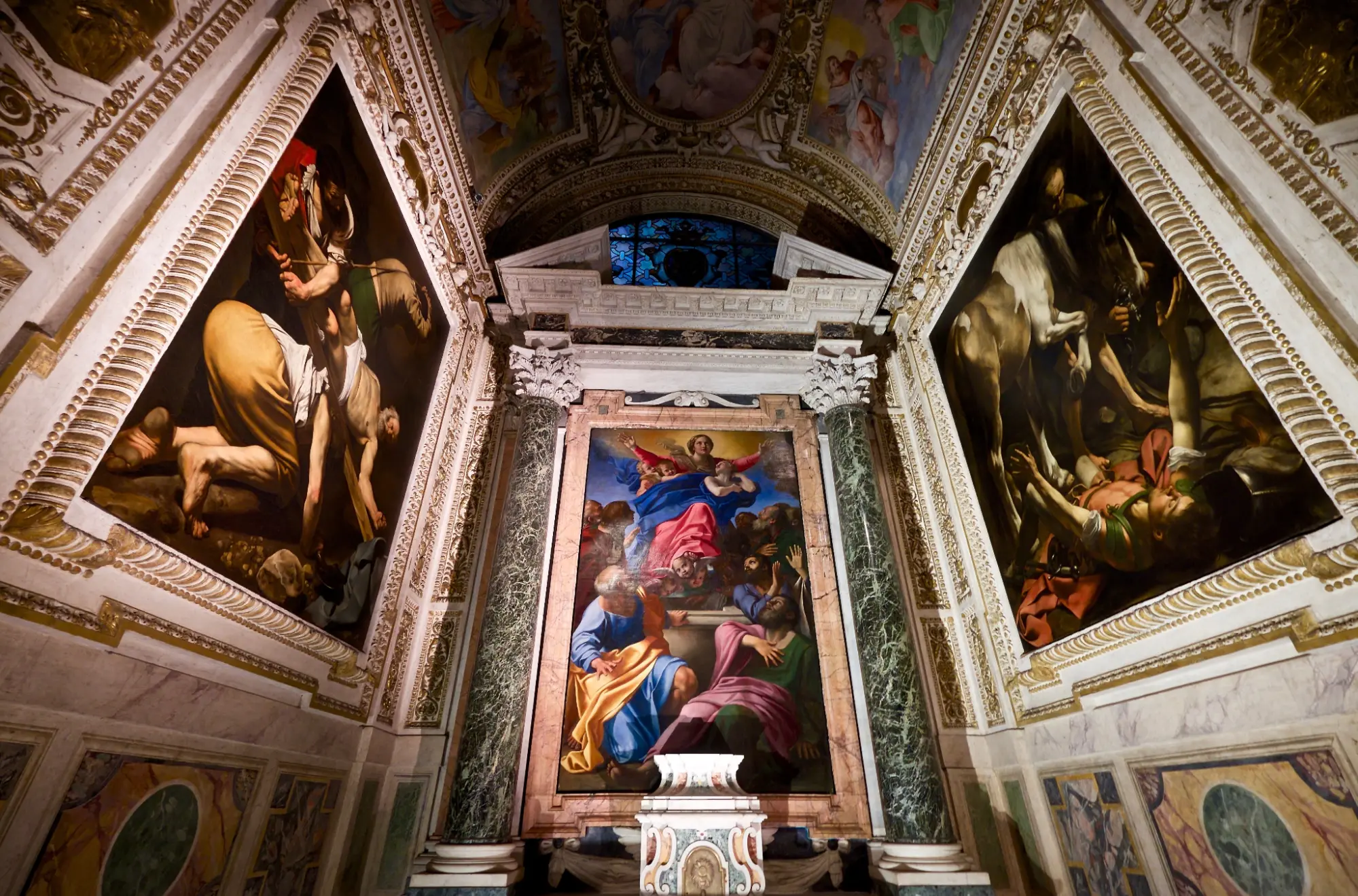
These paintings show his signature chiaroscuro—striking contrasts of light and dark.
Tip: Go during daylight for the best natural lighting.
That is all or the free walking stroll…
I have created my own google maps for the directions I prefer doing when I’m exploring the city and they follow the itinerary above.
You can change your ways of course!
Where to see Caravaggio for free in Rome
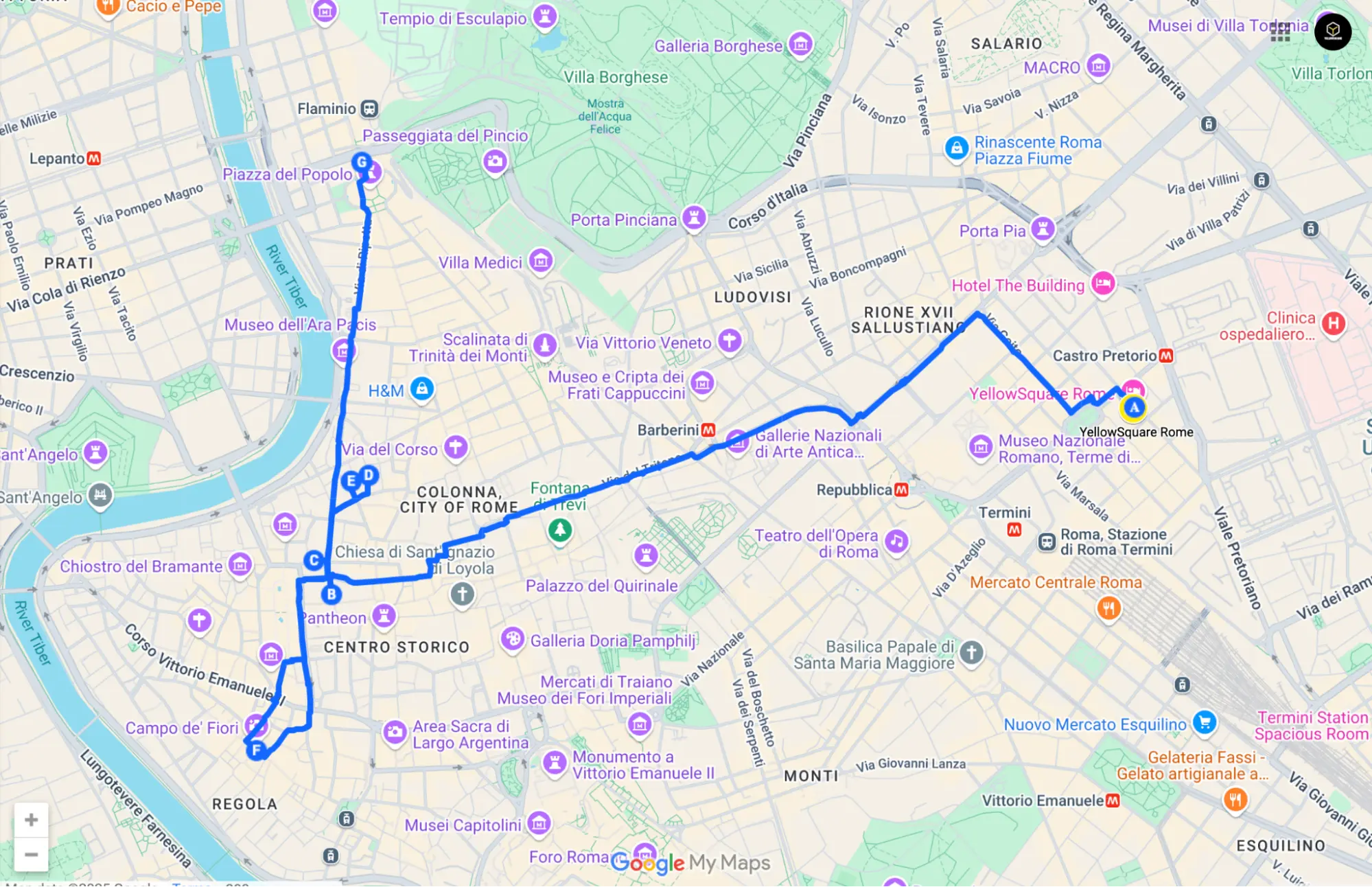
Want More Caravaggio?
If you’re still craving more after your free walk, visit these museums (ticket required):
1. Galleria Borghese
After the free walking tour I just mentioned above, you can go up from Piazza del Popolo, pass by the beautiful “Villa Borghese” and head to the “Galleria Broghese”
Address: Piazzale Scipione Borghese, 5, 00197 Rome
Works: Boy with a Basket of Fruit, David with the Head of Goliath, Saint Jerome Writing
Price: €13–€17 – Reservation required
2. Palazzo Barberini
Address: Via delle Quattro Fontane, 13, 00187 Rome
Work: Judith Beheading Holofernes
Price: €12 – Tickets at entrance or online
3. Capitoline Museums
Address: Piazza del Campidoglio, 1, 00186 Rome
Work: The Fortune Teller
Price: €15–€16 – Available online or at the entrance
4. Galleria Doria Pamphilj
Address: Via del Corso, 305, 00186 Rome
Works: Rest on the Flight into Egypt, Penitent Magdalene
Price: €14 – Tickets available online or at the door
Tips for Your Caravaggio Walk in Rome
- Best time to visit: Mornings or late afternoons (for better church lighting)
- Entry fees: Churches are free; museums are not
- What to bring: Comfortable shoes, water, and coins for donations
- Transport for slow walkers: Metro Line A to Flaminio (Santa Maria del Popolo) or Barberini (Palazzo Barberini)
This self-guided tour is a nice way to experience the intensity of Baroque Rome through Caravaggio’s eyes—and without spending a cent!
P.S. I’ve created a custom Google Map with this route saved under “Caravaggio’s Free Walk” + an extra layer for “Caravaggio’s payed entry” Make sure to book those tickets in advance.
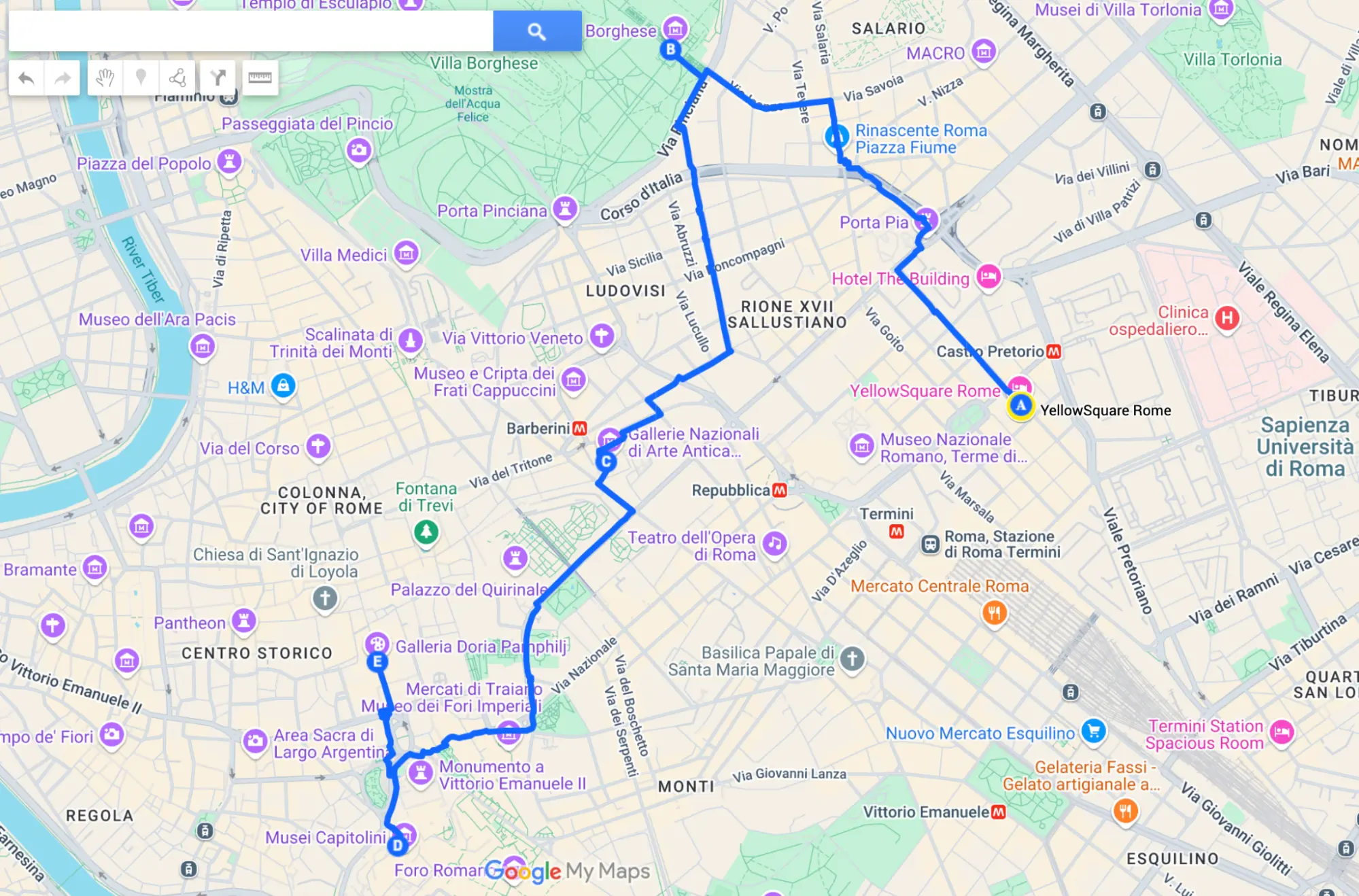
I hope this inspired you to explore more of Rome and dive into Caravaggio’s life and art.
Have a good one! 🙂
Read more posts
Rome
A Cinematic Guide to Rome
The Eternal City has captivated storytellers for millennia; from Ancient Roman historian Livy’s History of Rome to the 2024 remake of Gladiator starring Paul Mescal, Rome remains at the center of the public eye. Whether it is because we are fascinated with the violent history of the gladiators or compelled by the rich religious significance of the city, Rome has been transformed many times into a real-life movie set to entertain audiences worldwide. On your visit to Rome, take some time to visit these places where iconic scenes were filmed and stand amid cinematic history.
Films
1) La Dolce Vita, 1960
Filmed during Rome’s “golden age” of the 1950s and 60s, this iconic film directed by Federico Fellini is perhaps best known for its provocative, romantic scene of the Trevi Fountain. Even those who have not seen the era-defining film may recognize the iconic shot of Swedish actress Anita Ekberg stepping fully clothed into the pearly blue waters of the Trevi for a spontaneous dip with co-star and Italian heartthrob Marcello Mastroianni. While you may be tempted to invoke the carefree, luxurious lifestyle exuded by the film, resist the urge to take a dip in the fountain, unless you want a hefty 450 euro fine as a souvenir. Still, you can admire the intricately carved Oceanus and his horses, shell-shaped chariot, and tritons entirely for free. Pro tip: the best time to visit the Trevi is around 1:00 a.m., when it’s lit up against the night sky and most of the tourists have gone to bed.

2) The Talented Mr. Ripley, 1999
Spanning Rome, Venice, and the Amalfi Coast, this psychological thriller stars Matt Damon, Jude Law, and Gwyneth Paltrow and culminates in a shocking twist of betrayal, lies, and intrigue. If you have not seen this iconic film, it’s a must-watch before making the journey to Rome. Damon visits many iconic spots such as Piazza di Spagna throughout his increasingly intense trip, often with a secret agenda. This exciting film can’t be missed, and neither can the iconic Piazza di Spagna, which gets its name from the Palazzo di Spagna, the Spanish Embassy for the Vatican, at the top of the staircase. Join one of Yellow’s tours to visit this location and other iconic sites in Rome!

3) Gladiator, 2000
While this beloved action film was not actually shot in the Colosseum, it evokes the spirit of the real fights and games that were held in Rome’s most astounding attraction. Russell Crowe and Joaquin Phoenix star in the original, and fan-favorites Paul Mescal and Pedro Pascal in the 2024 remake. Both versions, directed by Ridley Scott, portray the Colosseum and the gladiators that fought bravely in it, oftentimes to the death. We recommend booking tickets to the Colosseum in advance to skip the line and have more time to enjoy the Eternal City and all it has to offer.


4) The Lizzie McGuire Movie, 2003
Many Gen-Z travelers will recall this light-hearted, spirited movie from their childhood. The iconic character Lizzie McGuire journeys to Rome on a class trip and accidentally becomes a pop star and falls in love with a charming Roman boy, Paolo. The pair of young lovers ride a cherry-red Vespa across the city and whizz past many iconic sites, including the Pantheon and Piazza della Repubblica. Hostels like the Yellow are a great way to meet new people when traveling solo, and who knows—maybe you will find love in Rome, too!
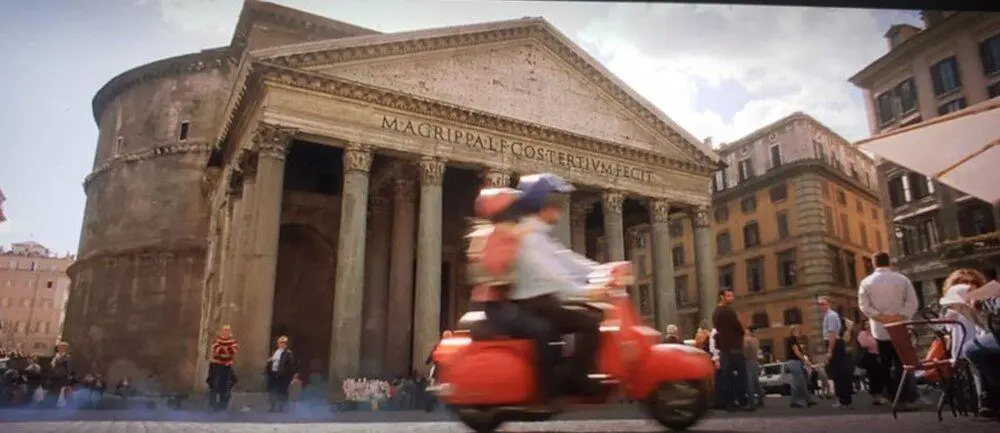

5) Eat, Pray, Love, 2010
This film starring Julia Roberts encompasses perhaps the greatest number of sites in Rome on this list. Inspired by the novel by Elizabeth Gilbert, the protagonist embarks on a soul-searching journey to Italy, India, and Indonesia in an attempt to reconnect with herself. In Rome, of course she focuses on “Eat.” Follow in her footsteps and sample some of the best gelato in Rome, or slurp down fresh spirals of spaghetti in the city’s most beautiful piazzas. Stroll down Via dell’Orso and try your hand at drinking water from one of the nasone, fountains of free fresh water that flow all over the city, like Liz does.
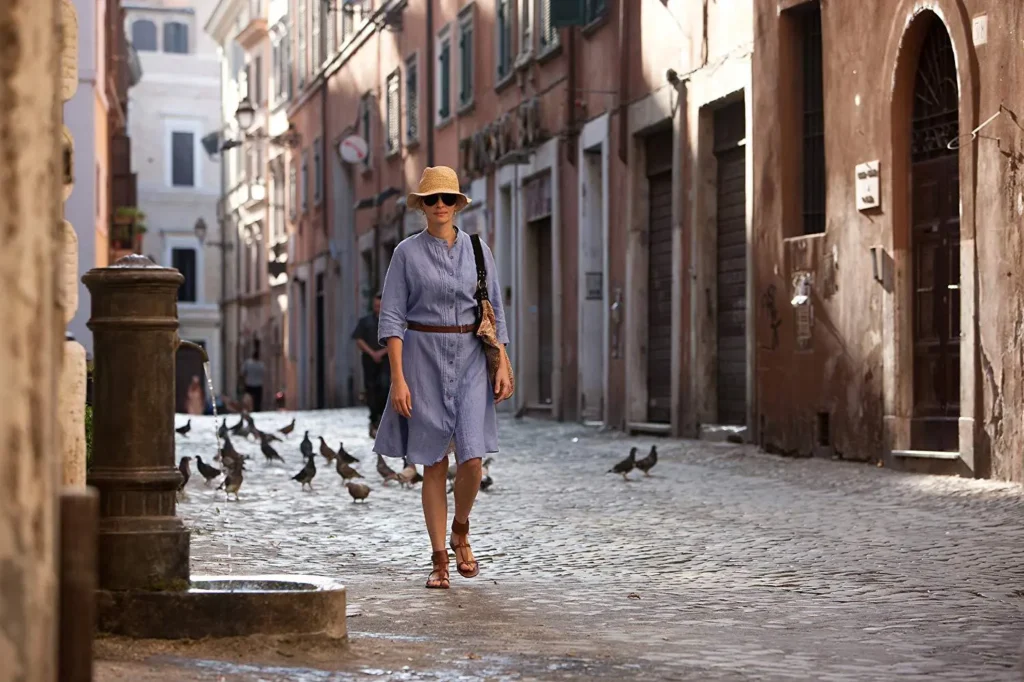
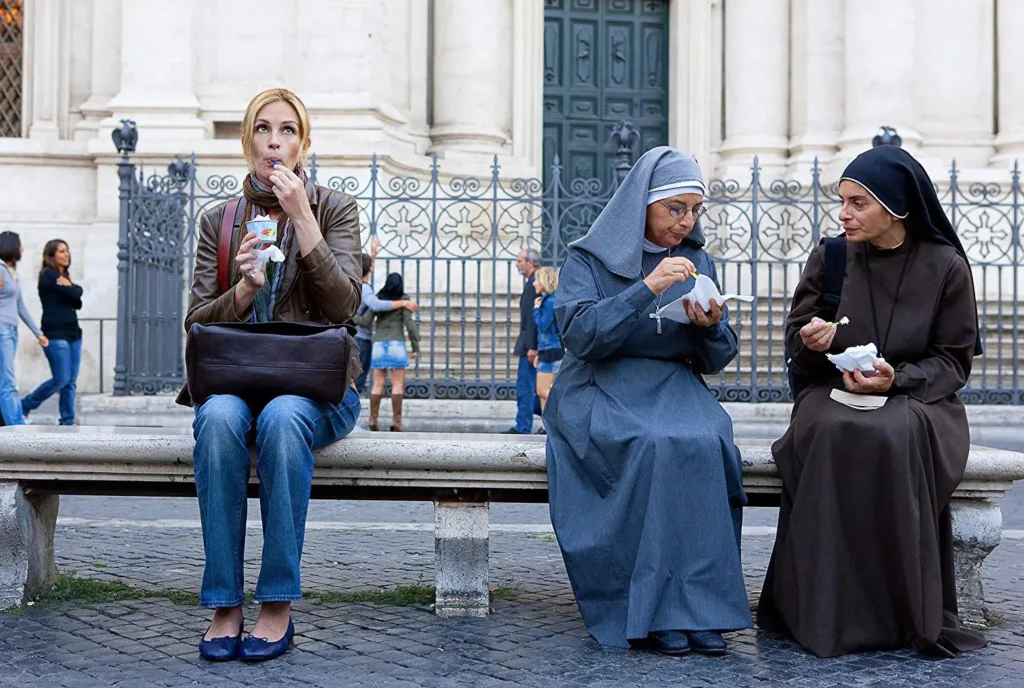
All of these iconic destinations can be easily reached by foot, bus or metro from YellowSquare Rome’s convenient location near Termini station. Whether you come to Rome to follow in the footsteps of your favorite movie stars or to embark on a life-changing solo journey, you will make plenty of memories worthy of the movies as a guest at the Yellow.
Sources:
https://www.turismoroma.it/it/pagina/la-dolce-vita
https://www.wantedinrome.com/news/italy-rome-tourists-fined-bathing-trevi-fountain.html
https://almostginger.com/the-talented-mr-ripley-filming-locations/
https://www.cntraveler.com/story/where-was-gladiator-ii-filmed
https://www.cineguides.com/the-lizzie-mcguire-movie-2003-filming-locations
https://almostginger.com/eat-pray-love-filming-locations-rome/
https://www.rome.net/piazza-di-spagna#:~:text=The%20Piazza%20di%20Spagna%20
Read more posts
Rome
Explore the LGBTQ+ Scene in Rome!
Rome is not just one of the most beautiful cities in the world—it’s also one of the most lively for the LGBTQ+ community. With a rich scene, the capital offers welcoming venues, unforgettable nights, and an inclusive atmosphere. Whether you’re a local or just visiting, this guide will help you discover the best nightlife and gay-friendly spots in the city.
The two most iconic areas for the LGBTQ+ community are “Gay Street” (near the Colosseum) and the Pigneto neighborhood. The considered “Gay Street” is perfect for a relaxed aperitivo, while Pigneto, with its artsy and alternative vibe, is ideal for those seeking a more creative and refined atmosphere.
But Rome’s LGBTQ+ scene doesn’t stop there! With incredible diversity, the city offers a wide array of experiences: bars, nightclubs, and even cultural hubs for every taste and mood.
Here are some must-visit spots to enjoy the best of Rome’s LGBTQ+ nightlife.
Bars and Venues
Coming Out
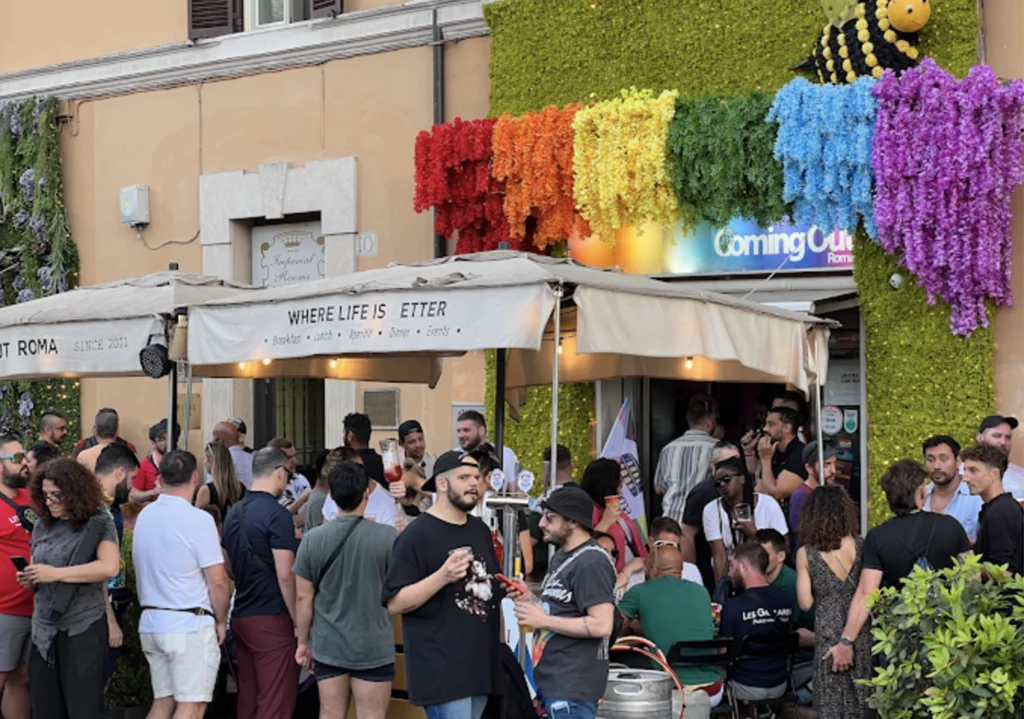
This bar played a key role in transforming Via S. Giovanni in Laterano into Rome’s Gay Street. What began as a small bar near the Colosseum, has now become a central hub for the LGBTQ+ community in the city. The Coming Out is the perfect place to meet new people or simply soak in the unique atmosphere of Gay Street.
Location: Coming out
101 Roma Club

Nestled between Termini and the Colosseum, this nightlife spot is perfect for those seeking a relaxed and inclusive environment. You can mingle in the main bar area or enjoy more privacy in the intimate lounge. Its motto says it all: “Be free to be yourself.” If you’re looking for a laid-back, no-judgment vibe, this is the place to be.
Location: 101 Roma Club
Malo Glitter Bar address
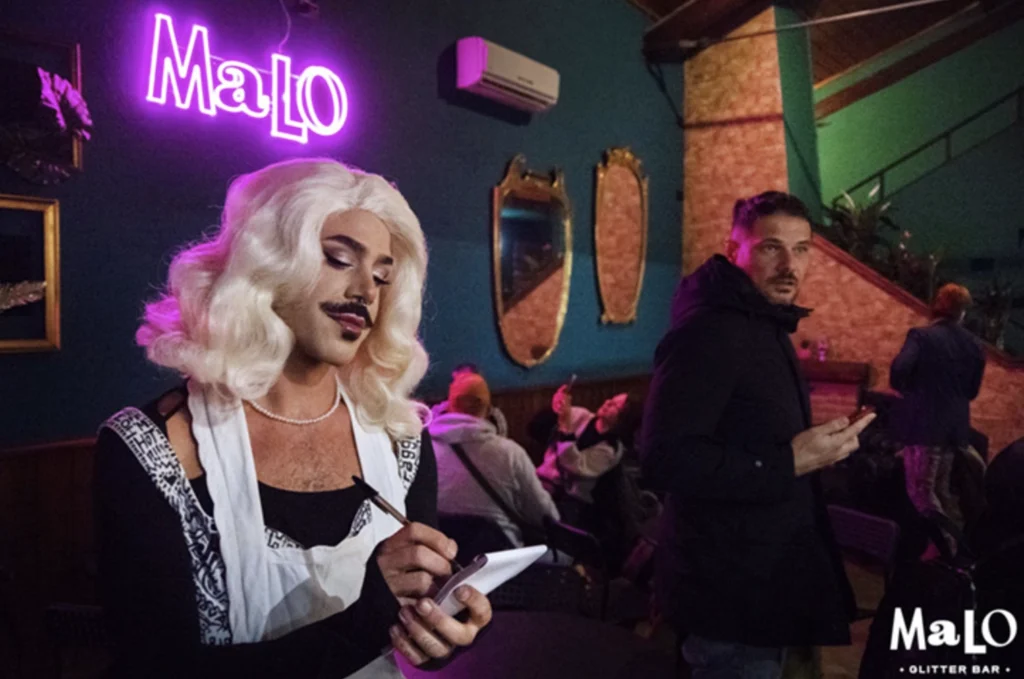
In the heart of Pigneto, Malo Glitter Bar is a perfect mix of culture and fun. Beyond serving unique, high-quality cocktails, this venue hosts art exhibitions, drag queen performances, book presentations, and thought-provoking talks. It’s a creative space where art and inclusivity meet, making it a standout destination for the LGBTQ+ community.
Location: Malo Glitter Bar
Where to Dance?
Rome is the perfect city for anyone who loves dancing late into the night. With a variety of LGBTQ+ events, there’s always something happening. Here are some of the most iconic parties.
GIAM

THE Saturday night party is GIAM! Held at Planet Club in the EUR district (here is the address), this event features international DJs, extraordinary performers, and an electric energy that lights up Rome’s nights year-round. If you love electronic music and a high-energy vibe, this is the party for you.
Location: GIAM
POPPE Party
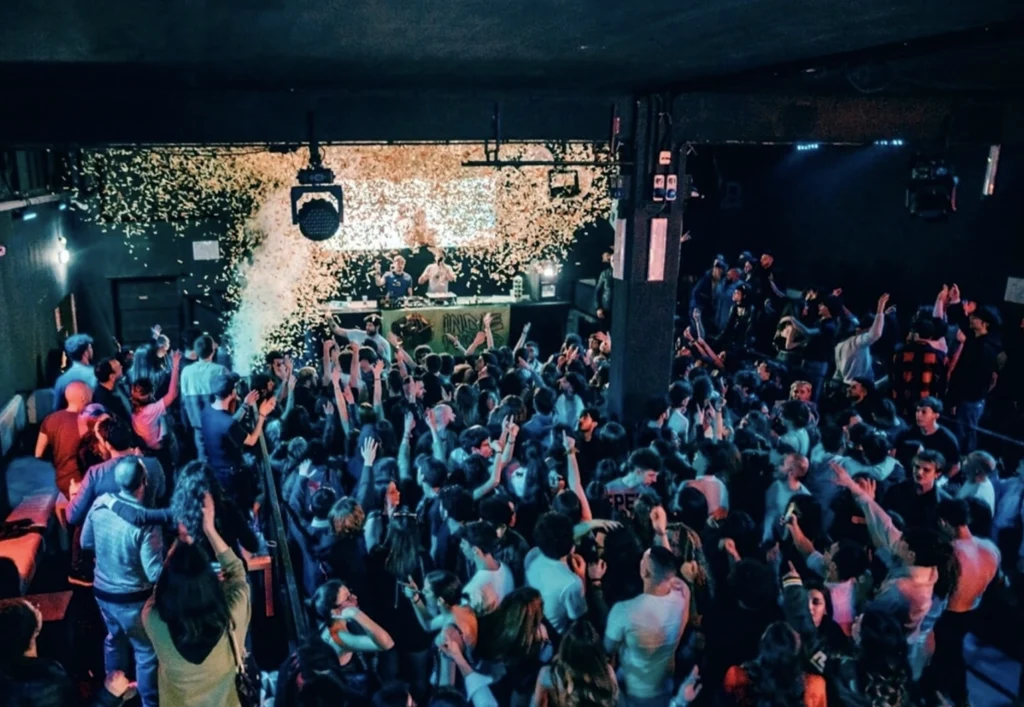
This queer-friendly event celebrates pop culture in all its forms. Every other Saturday at Monk , you can dance to R&B beats, nostalgic remixes, and current hits, all curated by top DJs. It’s the ideal night for pop music lovers and anyone looking for a mix of nostalgia and modern flair.
Location: POPPE party
Latte Fresco
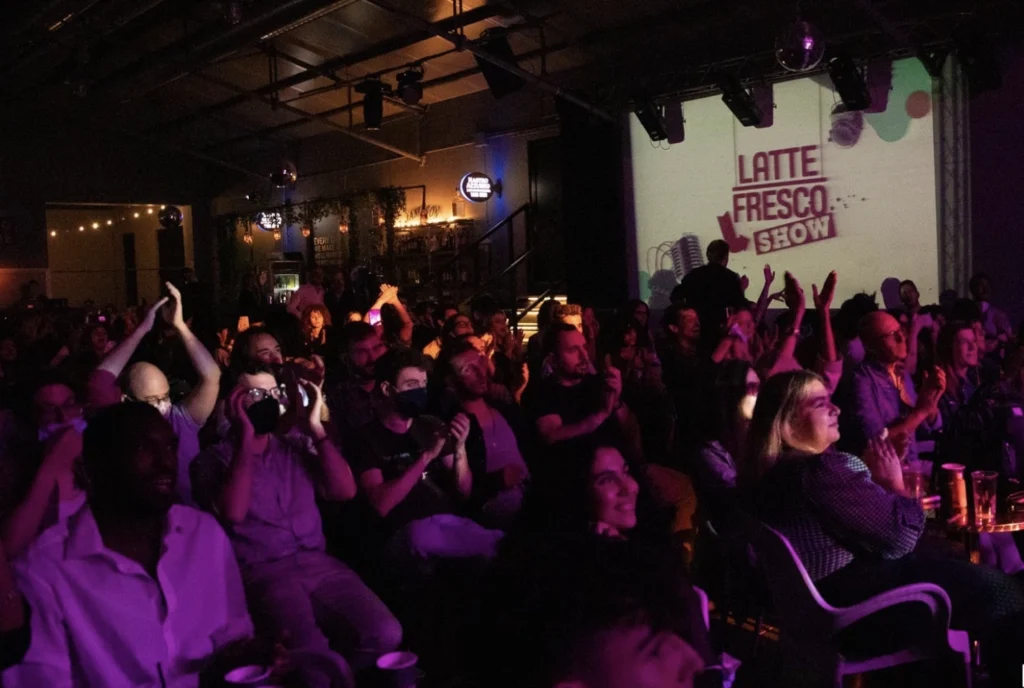
One of Rome’s most diverse party takes place every Friday at Largo Venue. Every Friday, you can enjoy a mix of stand-up comedy, karaoke, and drag performances before midnight—perfect for having a drink with friends. After midnight, unitl 4 AM, the dance floor comes alive with a wide range of music, all accompanied by contests where the audience can take the stage and dance alongside the DJs and drag queens.
Location: Latte Fresco
More than a Night Out: Culture and Community
If you’re looking for something beyond drinks and dancing, Rome also offers spaces like LGBTQ+ cultural centers. Here you can attend cultural events and activism-focused activities, enriching your experience within the community.
Ready to Discover Rome?
These are just a few suggestions for exploring Rome’s LGBTQ+ scene, but there’s so much more to discover! Go out, have fun, and let yourself be surprised by a city that knows how to welcome you with warmth and color. 🌈✨
With love, Chiara
Read more posts
Rome
A Paw-sitively Roman Adventure: A Guide to Rome's Cats
Rome, a city steeped in history and culture, has a deep-rooted connection with its feline inhabitants. Cats have been an integral part of Roman life for centuries, their presence woven into the fabric of the city’s history and culture. Wondering where you can meet them? Read along!
A Historically purrfect partnership
The relationship between Romans and cats dates back to ancient times. Romans were known for their practical approach to animal husbandry, and cats were valued for their ability to control rodent populations. This practical benefit cemented the cats’ place in Roman society.
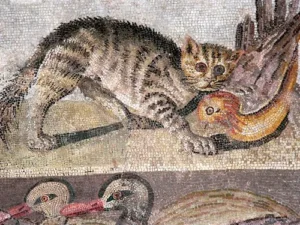
But beyond their practical role, cats have also held cultural significance in Rome.
Throughout history, many famous Romans have expressed their love for cats. One notable example is the poet Catullus, who wrote several poems about his pet cat, Bituitus.
Particularly in the Empire Age, felines were considered sacred by Romans, influenced by the cult of Isis, an Egyptian goddess who was widely worshiped in Rome at that time. Isis was often depicted with a cat or a sacred cat cub, symbolizing her protective and nurturing qualities.
Rome’s Gattare: a Millenary Love Story
The cult of Isis was particularly popular among women, who sought her help in matters of love, fertility, and childbirth.
This connection between cats and women is also reflected in the Italian language: the word gattara is Roman slang which refers to a woman who cares for stray cats. These dedicated individuals play a crucial role in the lives of Rome’s feline population, providing food, shelter, and medical care to cats in need.
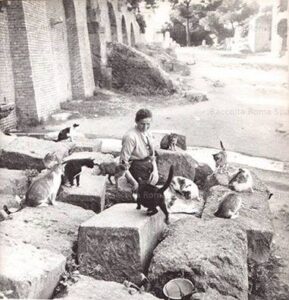
Cats in Modern Rome
Today, cats continue to thrive in Rome. They can be found strolling through the city’s historic squares, lounging in sunny windowsills, and exploring the ancient ruins. Many Romans have a deep affection for cats and treat them as cherished members of their families.
Here’s a few places where you can meet them, or even support them with donations, while you enjoy the beautiful sceneries of the Eternal City:
- Piramide Cestia: https://maps.app.goo.gl/p7zLBeKxkQdKdzXu5
The ancient Roman tomb of Piramide Cestia is also a sanctuary for a thriving colony of cats. These felines have made the pyramid their home, adding a touch of charm to the historic site. - Porta Magica: https://maps.app.goo.gl/xs7C6V7UHJrQcLJPA
Porta Magica, a mysterious archway located in the Prati district of Rome, is also home to a small but friendly feline colony. They can often be seen lounging on the steps or exploring the surrounding area. - Torre Argentina: https://maps.app.goo.gl/5YesZ5ZmA9iUXcwo6
Torre Argentina, a historic archaeological site in Rome, is renowned for its thriving feline colony. This group of cats has made their home in the ruins of ancient Roman temples, creating a unique and heartwarming sight. - Cimitero Monumentale del Verano and Cimitero Acattolico: https://maps.app.goo.gl/ctSfTb9d1V6sqKsk8
These two cemeteries in Rome, known for their historical significance and beautiful architecture, are also home to feline colonies. The cats have found refuge among the tombs and monuments, creating a unique and peaceful atmosphere.
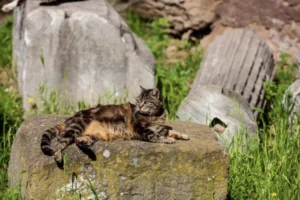
Bonus: CATS – A Roman Meow-sical
The iconic musical CATS has been adapted for Italian audiences in 2023 with a unique Roman twist. Set against the backdrop of the Eternal City, this Italian production captures the essence of the original while incorporating elements of Roman culture and history.
With Ancient Roman ruins in the stage background, the musical’s setting provides a captivating and authentic backdrop for the Jellicle Cats’ annual Jellicle Ball.
You can enjoy this endearing performance, for the second consecutive year, at Teatro Sistina starting May 2025
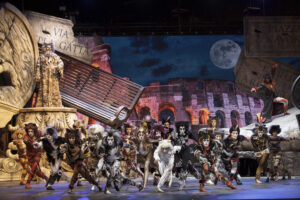
How to get there: https://maps.app.goo.gl/vmqf5HZtcmM52A5E6
The bond between Romans and cats is a testament to the enduring love and respect that humans can have for animals. Cats have played a vital role in the history and culture of Rome: as the city continues to evolve, the presence of cats will undoubtedly remain a cherished part of its identity.
Read more posts
Rome
Six Months Rome Insights
Hey dude! Hope you’re doing great! If you’re thinking about coming to Rome for the first time, I have to admit, I’m a bit envious. I still remember the excitement of seeing this city for the first time—it captivated me so much that I decided to stay.
I’ll do my best to give you a snapshot of how I’ve experienced this city over the last few months.
Where Anything Can Happen
Rome is that city where anything can happen. On any given Wednesday, you might see James Franco in Trastevere signing books or Harry Styles at Porta Portese buying rare vinyl records. And if that doesn’t surprise you, wait until the following week when Edward Norton (the other guy from Fight Club) presents a movie at an open-air cinema. That’s Rome for you: a box full of infinite surprises. How would I define it? In one word: stimulating.
Check more here:
https://www.romeinternational.it/en/edward-norton-in-rome-meet-the-public/https://cinematroisi.it/
“James Franco presenta Spring Breakers a Monte Ciocci”
“Edward Norton a Roma parla del Cinema Italiano al Cinema in Piazza di Roma”
A Cultural Mosaic
Rome is the Tower of Babel, but with more flavor and better coffee. Here, cultures don’t just coexist; they embrace each other in a delicious chaos that only this city can offer. Walk through its streets, and you’ll hear a symphony of languages, see markets filled with products you didn’t know existed, and discover trattorias where every dish tells a story. Trust me, Rome is a place that embraces. It’s a festival of diversity wrapped in perfectly orchestrated chaos.
Food: More Than Just a Cliché
When I first arrived, I remember being amused by what I considered a parade of neurotics obsessed with details. But I have to admit, this obsession with culinary precision, which is practically a matter of general culture in Italy, results in the lowest standard of food here being excellent.
And after a while, trust me, you learn that pecorino is sacred, the guanciale vs. pancetta debate and their proper uses, plot twist (there’s more than just spaghetti), pasta must always be al dente, fish and cheese can get you kicked out of Italy, what a “normal coffee” really means, and so much more.
Roman Philosophy in Two Words: Sti Cazz$
So, one day I was talking to my friend Manuele (a Roman chef, true to the stereotype) about what sti cazz$ really means. He told me, “It’s like saying ‘who cares,’ but it’s more than that.” That’s how you survive in Rome. The metro is late? Sti cazz#. Your dinner came out late? The waiter messed up your order? Sti cazz$. Basically, nothing is serious enough to worry too much about. Everything has a solution, and if it doesn’t… sti cazz$.
(Disclaimer!! please, don’t search the word on Google Images)
Ci vediamo presto!
Okay, my fellow travelers, all roads lead to Rome. I’ve barely scratched the surface of what you can find here, but trust me, it’s worth the journey.
See you here for an aperitivo!
Pura Vida, Ale
Read more posts
Rome
From The YellowSquare Hostel to Michelangelo's Masterpiece
Hey there, travelers! Ready to uncover one of Rome’s most famous treasures—the Sistine Chapel? Let’s dive into the fascinating history of this awe-inspiring masterpiece and make our way there step by step from The Yellow Hostel.
Where It All Began
The Sistine Chapel’s story starts in the late 15th century when Pope Sixtus IV decided to create a place worthy of divine worship. Little did he know, he was setting the stage for one of the greatest artistic achievements of all time!
Fast forward a bit, and enter Michelangelo—the artistic genius tasked with painting the chapel’s ceiling. For four years, he poured his heart and soul into creating breathtaking frescoes that still leave visitors in awe today.
Aside from its stunning beauty, the Sistine Chapel has played a crucial role in history. It’s where papal conclaves gather to elect new popes—a tradition that’s been going strong for centuries!
Navigating to the Sistine Chapel from The Yellow Hostel
Okay, time to hit the road! Leave The Yellow Hostel and head northeast on Via Cavour. Keep an eye out for cool shops and cafes along the way!
As you stroll along Via XX Settembre, you’ll pass by the majestic Palazzo del Quirinale. Don’t forget to snap a few pics of this impressive building!
Next up, you’ll come to Ponte Sant’Angelo—a historic bridge adorned with beautiful angel sculptures. Cross it to get to the Vatican Museums.
Follow the signs to the Sistine Chapel as you make your way through the Vatican Museums. Trust us, you won’t want to miss this!
As you step into the Sistine Chapel, get ready to have your mind blown. Look up, and you’ll see Michelangelo’s incredible ceiling frescoes depicting scenes from the Bible.
Now, don’t rush! Take your time to admire every detail of Michelangelo’s masterpiece, including his epic fresco “The Last Judgment” on the altar wall.
There’s something truly special about standing in a place that’s witnessed centuries of history. Soak in the spiritual atmosphere and let yourself be transported back in time.
Back at the hostel, take a moment to reflect on your incredible journey. Share your experiences with fellow travelers and maybe even sketch your own masterpiece!
Safe travels, adventurers!
